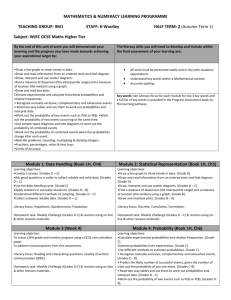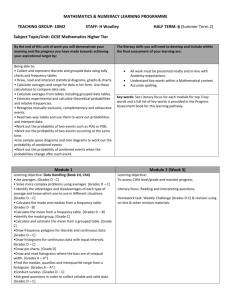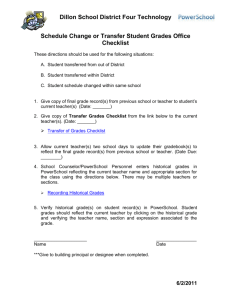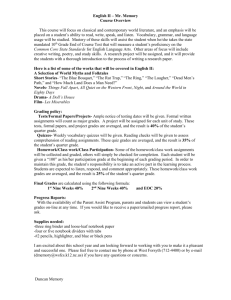MATHEMATICS & NUMERACY LEARNING PROGRAMME
advertisement
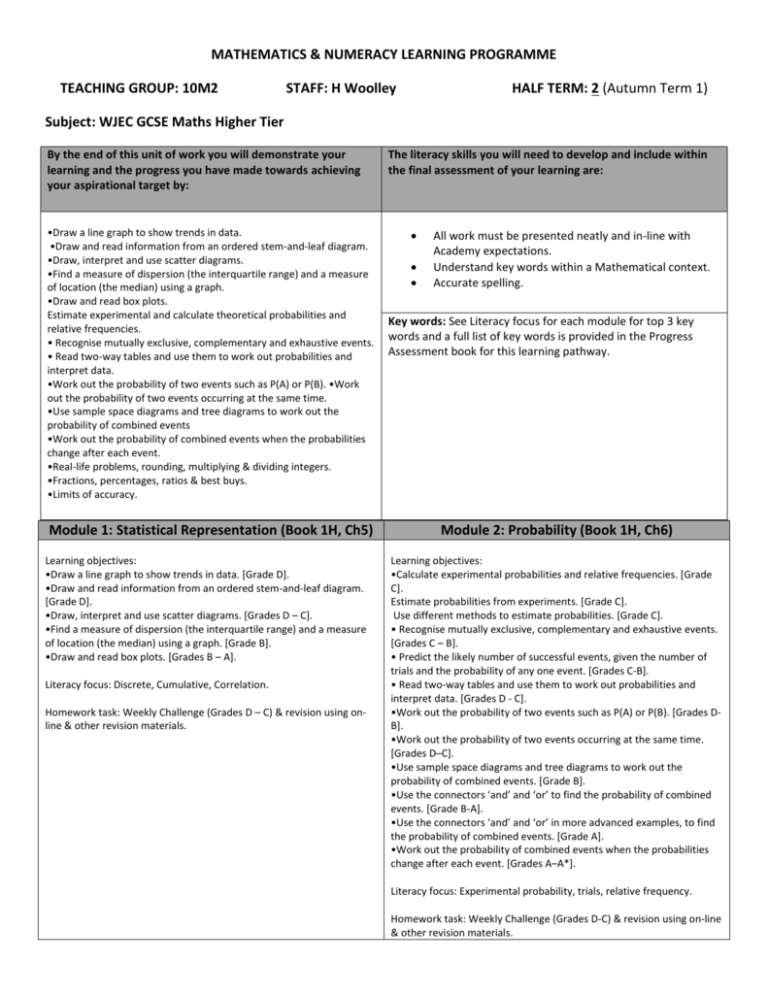
MATHEMATICS & NUMERACY LEARNING PROGRAMME TEACHING GROUP: 10M2 STAFF: H Woolley HALF TERM: 2 (Autumn Term 1) Subject: WJEC GCSE Maths Higher Tier By the end of this unit of work you will demonstrate your learning and the progress you have made towards achieving your aspirational target by: •Draw a line graph to show trends in data. •Draw and read information from an ordered stem-and-leaf diagram. •Draw, interpret and use scatter diagrams. •Find a measure of dispersion (the interquartile range) and a measure of location (the median) using a graph. •Draw and read box plots. Estimate experimental and calculate theoretical probabilities and relative frequencies. • Recognise mutually exclusive, complementary and exhaustive events. • Read two-way tables and use them to work out probabilities and interpret data. •Work out the probability of two events such as P(A) or P(B). •Work out the probability of two events occurring at the same time. •Use sample space diagrams and tree diagrams to work out the probability of combined events •Work out the probability of combined events when the probabilities change after each event. •Real-life problems, rounding, multiplying & dividing integers. •Fractions, percentages, ratios & best buys. •Limits of accuracy. Module 1: Statistical Representation (Book 1H, Ch5) Learning objectives: •Draw a line graph to show trends in data. [Grade D]. •Draw and read information from an ordered stem-and-leaf diagram. [Grade D]. •Draw, interpret and use scatter diagrams. [Grades D – C]. •Find a measure of dispersion (the interquartile range) and a measure of location (the median) using a graph. [Grade B]. •Draw and read box plots. [Grades B – A]. Literacy focus: Discrete, Cumulative, Correlation. Homework task: Weekly Challenge (Grades D – C) & revision using online & other revision materials. The literacy skills you will need to develop and include within the final assessment of your learning are: All work must be presented neatly and in-line with Academy expectations. Understand key words within a Mathematical context. Accurate spelling. Key words: See Literacy focus for each module for top 3 key words and a full list of key words is provided in the Progress Assessment book for this learning pathway. Module 2: Probability (Book 1H, Ch6) Learning objectives: •Calculate experimental probabilities and relative frequencies. [Grade C]. Estimate probabilities from experiments. [Grade C]. Use different methods to estimate probabilities. [Grade C]. • Recognise mutually exclusive, complementary and exhaustive events. [Grades C – B]. • Predict the likely number of successful events, given the number of trials and the probability of any one event. [Grades C-B]. • Read two-way tables and use them to work out probabilities and interpret data. [Grades D - C]. •Work out the probability of two events such as P(A) or P(B). [Grades DB]. •Work out the probability of two events occurring at the same time. [Grades D–C]. •Use sample space diagrams and tree diagrams to work out the probability of combined events. [Grade B]. •Use the connectors ‘and’ and ‘or’ to find the probability of combined events. [Grade B-A]. •Use the connectors ‘and’ and ‘or’ in more advanced examples, to find the probability of combined events. [Grade A]. •Work out the probability of combined events when the probabilities change after each event. [Grades A–A*]. Literacy focus: Experimental probability, trials, relative frequency. Homework task: Weekly Challenge (Grades D-C) & revision using on-line & other revision materials. Module 3 (Week 4) Learning objective: To assess CWA grade and monitor progress using a GCSE non-calculator paper. To address misconceptions from this assessment. Literacy focus: Reading and interpreting questions. Quality of written communication (QWC). Homework task: Weekly Challenge (Grades D-C) & revision using on-line & other revision materials. Module 4: Number (Book 1H, Ch1, 2 & 3) Learning objectives: •Solve problems set in a real-life context. [Grade D–C] • Round to a given number of significant figures. [Grade D–C] •Approximate the result before multiplying two numbers together. [Grade D–C] •Approximate the result before dividing two numbers. [Grade D–C] •Round a calculation, at the end of a problem, to give what is considered to be a sensible answer. [Grade D–C] •Multiply and divide positive and negative numbers. [Grade D] • Find one quantity as a fraction of another. [Grade D–C] •Increase and decrease quantities by a percentage. [Grade D–B] •Express one quantity as a percentage of another. [Grade D–C] •Work out percentage change. [Grade D–C] •Calculate compound interest. [Grade C–B] •Solve problems involving repeated percentage change. [Grade C–B] •Calculate the original amount, given the final amount, after a known percentage increase or decrease. [Grade C–A] •Simplify a ratio. [Grade D–C] •Express a ratio as a fraction. [Grade D–C] •Divide amounts into given ratios. [Grade C] •Complete calculations from a given ratio and partial information. [Grade C] •Find the cost per unit weight. [Grade D] •Find the weight per unit cost. [Grade D] •Use the above to find which product is the cheaper. [Grade D] •Find the limits of accuracy of numbers that have been rounded to different degrees of accuracy. [Grade C–B] •Combine limits of two or more variables together to solve problems. [Grade B–A*] Literacy focus: Integer, multiplier & limits Homework task: Weekly Challenge (Grades D-C) & revision using on-line & other revision materials.
